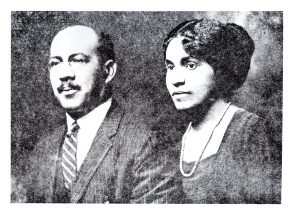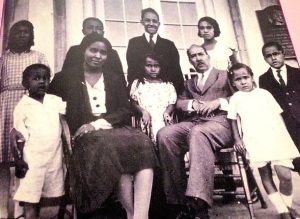Victor and Constance Daniel
Cardinal Gibbons Institute’s First Principal and Vice Principal

In 1924, the Cardinal Gibbons Institute in St. Inigos, Maryland trustees hired Victor H. Daniel and his wife Constance E.H. Daniel to serve as the first Principal and Assistant Principal of the Institute. It was the first African American high school in St. Mary’s County. The mission of the Catholic school was to provide agricultural and industrial education for the African American youth of Southern Maryland.
The couple met and married at Tuskegee Institute, and they brought the educational concepts practiced at that widely admired institution to their work at Cardinal Gibbons Institute. They practiced what is called emancipatory education.
The Daniels oversaw the opening of the Institute with Father John LaFarge, and they continued to head the school successfully until its temporary closing in 1933. In the decade that they spent leading the school, they promoted progressive ideas about the role of education in transforming students’ lives and uplifting the community.
They had strong opinions about the curriculum, and though they agreed with the founders that the students should receive practical training in the industrial and agricultural fields, they believed that students needed to learn about African American history and culture, literature, and the arts as well. Their goal was to free the minds of young people from racial stereotypes and misconceptions about American history. The Daniels encountered resistance from some of the prominent trustees, who disagreed with their goals and methods, and these tensions grew over the years in spite of the solid accomplishments the Daniel’s achieved with the academic programs and community outreach.
The Institute struggled financially over the years and when the Depression hit in the 1930s, a financial crisis developed. The Daniels and other teachers went unpaid for six months, and, in 1933, the trustees decided to terminate their contracts immediately and close the school down temporarily with debts still outstanding. It created a major crisis for all involved and a personal ordeal for the Daniels family. The Daniels and their children, who lived in a farmhouse on the campus, found themselves, as winter approached, with insufficient funds for food and heat and were eventually forced to leave.
The Daniels went on to have distinguished, productive careers elsewhere, but it was a very sad ending to their association with Cardinal Gibbons Institute. Under their leadership, the school had received accolades from organizations all over the country including, the National Education Board, Hampton University, Howard University, Tuskegee Institute, and the University of Maryland. They had contributed so much to the success of the fledgling school and had changed the lives of their students and the whole community for the better.
“Emancipating the Negro’s mind is a far greater task than emancipating his body ever was. And emancipating the mind of his white brother is still harder. Hand-me-down teachings die hard. Inter-racial movements have some slight effect. Sociological surveys are helpful. But the real weight of the burden still rests squarely where it has always rested since emancipation, on the shoulders of education, and particularly on the shoulders of Negro institutions of learning”. Constance Daniel in “Cardinal’s Notebook” 1930, pg. 15. Retrieved from http://digitalcommons.lmu.edu/ce/vol4/iss3/5

Additional Resources
To “Be of Some Good to Ourselves and Everybody Else”: The Mission of the Cardinal Gibbons Institute, 1924-1934. Cecilia A. Moore, U.S. Catholic Historian. Vol. 16, No. 3, Sources of Social Reform, Part One (Summer, 1998) , pp. 45-66 (22 pages) Published By: Catholic University of America Press
https://www.jstor.org/stable/25146253
Historical Marker Database, Cardinal Gibbons Institute, https://www.hmdb.org/m.asp?m=128947
“Victor and Constance Daniel and Emancipatory Education at the Cardinal Gibbons Institute”, by C. A. Moore, Journal of Catholic Education, 4 (3). Retrieved from
http://www.digitalcommons.lmu.edu/ce/vol4/iss3/5